| Content | Rupert Neve Designs' Shelford Channel, over a half century in the making, is the definitive evolution of Mr. Neve's renowned 80 Series channel module technology, updated and refined for the contemporary studio. The Shelford Channel is fitted with Rupert's latest Class A transformer-gain mic preamp, the best-of-the-classics Inductor EQ from the Shelford 5052, a punchy diode-bridge compressor, the alluring analog textures of variable Silk saturation, a state-of-the-art dual-tap transformer output stage with massive headroom, and double the operating voltage of vintage designs. Offering rich tonal options for making audacious statements with your music, along with precision-detented controls for recall, the Shelford Channel delivers the authoritative sonic essence of classic Rupert Neve designs, along with modern versatility.
Input stage and transformer-gain mic pre
Rupert Neve's first new Class A, transformer-gain mic preamplifier in over 40 years makes its debut in the Shelford Channel. Rupert has spec'd this preamp with a direct-coupled transformer input; gain is provided by the custom transformer itself. The proprietary input transformer, and its meticulous integration with the surrounding Class A input amplifiers, plays an outsized role in the Channel's immediately recognizable sonics: punchy and creamy-smooth, with excellent isolation and vanishingly low noise.
The Shelford Channel's front-panel hi-Z instrument input uses the same discrete Class A field-effect transistor with transformer topology as Rupert Neve Designs' acclaimed RNDI; for gain, however, it utilizes the new RN4012 input transformer directly into the mic preamp. This design provides astonishing clarity on hi-Z sources, with substantial low-end weight and silky-smooth high frequencies. The DI also gives you a passive thru output to feed a guitar or bass amp.

- Mic-DI/Line: switches between microphone/direct injection input and line input
- GND Lift: disconnects the audio signal ground from chassis earth
- Signal LED: green indicates Signal Present; red indicates imminent input stage clipping
- Mic Gain: 12-way precision rotary, controls gain from 0dB to 66dB in 6dB steps
- Trim: rotary switch provides further continuous gain adjustment of +/-6dB
- 48V: switch engages phantom power on the mic input
- Phase: inverts the polarity of the signal path (illuminates when engaged)
- HPF Freq: engages a 12dB/octave highpass filter, variable from 20Hz-250Hz
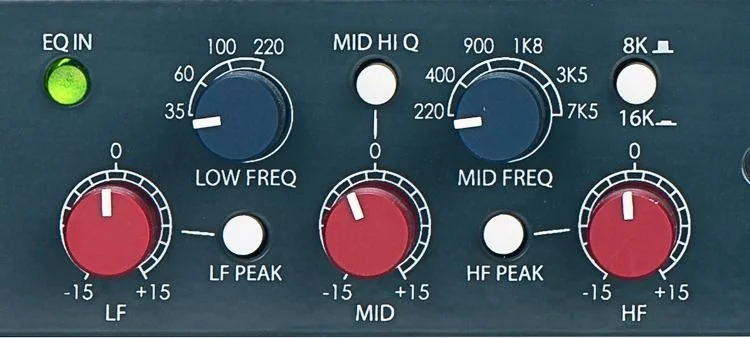
The best-of-the-classics inductor EQ
The Shelford Channel's EQ section is a 3-band, custom-tapped inductor circuit containing Rupert's favorite bands from his vintage equalizer designs. The low-frequency band is primarily based on the 1064 — acclaimed for its creamy, resonant bass. Unlike the 1064, though, the Channel gives you added dimension, punch, and control over your low end by letting you use the LF band as either a peaking or a shelving filter. The midrange band is based on the venerable 1073 and is perfect for sweetening instruments and vocals while nudging them forward in a mix. "Proportional Q" response also makes it ideal for attenuating problem frequencies. The high-frequency band is a hybrid design with the best of vintage and modern attributes. It should be noted that this EQ is in no way a clone; it's a decidedly modern design using components and techniques that simply did not exist in the 1970s — for instance, the use of capacitor-based topologies to achieve sonic richness and enhanced control.
- EQ In: engages all EQ frequency bands except HPF
- LF: adjusts up to 15dB of boost/cut at the selected low frequency
- Low Freq: 4-position rotary switch for selecting LF band corner or center frequency
- LF Peak: selects LF shelving (out) or peaking (in) mode
- Mid Hi Q: selects between a mid-band resonance of 2 (out) or 3.5 (in)
- Mid: adjusts up to 15dB of boost/cut at selected mid frequency
- Mid Freq: 6-position rotary switch selects center frequency of the midband EQ stage
- HF Peak: selects HF shelving (out) or peaking (in) mode
- 8K/16K: selects between an 8kHz (out) or 16kHz (in) center or corner frequency for HF band
- HF: adjusts up to 15dB of boost or cut at selected high frequency
The Super Diode-bridge Compressor
Like the Shelford Channel's inductor EQ and transformer-gain microphone preamp, the diode-bridge compressor/limiter is based on the topologies found in vintage Neve designs such as the 2254. It improves, however, on the early designs by the inclusion of full-wave rectification and a bevy of new control features. Although Rupert's vintage diode-bridge compressors were prized for their warm, punchy response, they were somewhat compromised by imprecise controls, attack-time inflexibility, low headroom, and high noise. The Shelford Channel's Super Diode-bridge Compressor delivers the attitude-packed, "in your face" sound of those classics, but with modern precision and flexibility — which makes it ideal on any source. Full Side-chain and stereo Link features are provided.
- Side Chain Insert Jacks (rear-panel): for fine tuning of compressor operation
- Comp In: engages the Channel's compressor-limiter section
- Threshold: sets level where the compressor "kicks in"
- Ratio: sets compression slope from 1.5:1 (minimal) to 8:1 (heavy)
- SC Insert: inserts rear-panel sidechain insert jacks into sidechain signal path
- HPF to S/C: routes highpass filter into the circuit that compressor uses to determine level
- Gain: for adding make-up gain to compensate for level attenuation lost to compression
- Timing: 6-position rotary adjusts attack/release speed of the compressor
- Link: links the sidechain control of multiple units for ganged or stereo operation
- Pre EQ: changes the order of compressor in the circuit chain
- Blend: mixes the dry and compressed signal for handy parallel compression
- Fast: speeds up both attack and release of the selected compressor time constant
Dual-tap transformer output
The Shelford Channel's output stage serves up the inimitable sound of Rupert Neve's classic designs while providing far more tonal versatility. The dual-tap output for the RN2042 square-core output transformer provides both high- and low-headroom outputs without compromising performance. The high-headroom tap takes advantage of the Shelford's higher-voltage design, delivering a pristine sound without non-linear output-stage coloration at high levels. The low-headroom tap, on the other hand, lets you drive the full voltage range of the Channel to accentuate this non-linear harmonic content — without clipping most pro interfaces. For vocals, drums, guitars, bass, and other instruments, this output lets you hit the transformer's sweet spot, which can inject life into a recorded performance in a way that other effects cannot.
The Silk and Texture controls
The Shelford Channel is packing a secret weapon the classics never had: its output transformer features the Silk Red/Blue and Texture controls from the Portico II Series that let you tailor the harmonic content and tonality of the output stage. By engaging these controls and sufficiently driving your output, you can dial in delectable 2nd- and 3rd-order harmonic distortion (that's the good kind) and saturation of the output transformer, imbuing your tracks with juicy rich thickness (think: 1073 on steroids) — with no danger of overloading the output stage. The Silk Red mode emphasizes harmonic content generated by the source's high frequencies; Blue mode, conversely, works off the low frequencies. The Texture knob controls the amount of added harmonic content. Disengage Silk, and your output is pristine and modern, while retaining Rupert's bigger-than-life transformer sonic signature.
The magical sound of Neve
Rupert Neve is an audio legend whose electronics designs defined the golden age of analog. Those of us at Sweetwater who have had the privilege of working on a Neve 8078 or its predecessors can attest to the fact that Neve's Series 80 consoles were indeed the pinnacle of hand-wired analog mixing desks. Mr. Neve has remained at the forefront of audio-circuit innovation for over half a century, and his current company, Rupert Neve Designs, continues to advance the state of the art with cutting-edge products that sound incredible and intelligently address the challenges of the digital age.
Rupert Neve Designs Shelford Channel Features:
- The definitive evolution of Rupert Neve's renowned 80 Series channel module technology
- A complete channel strip that delivers the essence of classic designs, along with modern versatility
- Input stage and transformer-gain mic pre
- Front-panel hi-Z direct input
- Best-of-the-classics inductor EQ
- Super Diode-bridge Compressor
- Dual-tap transformer output
- Silk and Texture controls
| Working inside the box? Sweetwater would like to recommend a summing mixer that will seriously up your game: the Rupert Neve Designs 5059 Satellite Shelford Edition. If you record and mix entirely within your DAW, you’re hampered by the inability to leverage the sonic advantages of high-quality analog outboard gear. Enter the 5059 Satellite. The 5059 gives you 16 channels — each with individual level and pan, plus insert and bus-2 send buttons. You get two stereo buses with RND’s proprietary Silk Texture controls, giving you effortless integration with outboard equipment, total control for two separate stem mixes, and the facility to dial in harmonic enhancement in two distinct flavors.
It’s a Neve
In serious audio circles, Rupert Neve needs no introduction. Large-format Neve consoles from the 1970s are considered by many to be the pinnacle of analog mixer design. Boasting the same design heritage and sonic perfectionism that went into the boards used to record countless hit records, the 5059 Satellite Summing Mixer graces your tracks with legendary Rupert Neve warmth, punch, and presence. With 16 channels of Rupert Neve designed Class A alchemy and flexible tonal and routing options, the Rupert Neve Designs 5059 Satellite Summing Mixer will take your DAW-based studio’s sound to a whole new level.
Dial in the Silk
The Rupert Neve Designs’ 5059 Satellite Summing Mixer’s continuously variable Texture controls with Silk and Silk+ modes let you fine-tune the harmonic ratio and tonality of each of 5059’s stereo buses. The Silk mode adds sparkle to your tracks by introducing alluringly airy transformer saturation in the high frequencies. Silk+ mode accentuates saturation in the low frequencies, adding density and thickness to the source — particularly desirable when you’ve got a dry, lackluster mix. Distinctly different sounding from equalization, Texture saturates the output transformers, adding sweet, musical even-order harmonics to your source material for authoritative, radio-ready mixes that blast right out of the speakers.
Flexibility: it’s a beautiful thing
The dual stereo outputs of the Rupert Neve Designs 5059 Satellite Summing Mixer are perfect for creating stem mixes, which you can enhance using the 5059’s Silk/Texture controls, then process through bus compressors or other devices via the inserts, finally feeding into the inputs of another mixer or your interface. You can send any input to stereo bus 1 or 2, and create two very different-sounding mixes from the same 16 channels. These are just some examples of the amazing flexibility you’ll enjoy when integrating the 5059 into your recording rig. Smartly attired in classic Shelford livery, the Rupert Neve Designs 5059 Satellite Summing Mixer is housed in a rugged, fan-cooled 2U steel chassis for dependable, no-compromise professional performance year after year, in the studio or on the road.
The legend continues
Rupert Neve’s 80-series consoles had a huge, punchy, and authoritative sound that defined the sound of ’70s rock. From London to New York to Los Angeles and beyond, top studios were installing Neve boards as fast as they could. By 1977, with the introduction of the NECAM automation system, 80-series boards were the main component of the success formula for any recording studio with world-class aspirations. Mr. Neve’s current company, Rupert Neve Designs, continues to advance the state of the art with cutting-edge products that sound incredible and intelligently address the challenges of the digital age. With your Rupert Neve Designs 5059 Satellite Shelford Edition from Sweetwater, the legend continues.
Rupert Neve Designs 5059 Satellite Summing Mixer Shelford Edition Features:
- Classic Neve: Class A, all transformer-balanced, and awesome-sounding
- Zero crossover distortion and unmatched purity
- Custom transformers provide galvanic isolation and serve up "larger than life" sound
- Sets a standard for rackmountable summing mixers
- 16 inputs/channels (with level controls, pans, and inserts); 2 stereo buses
- Send any input to stereo bus 1 or 2, each with variable Silk/Silk+ Texture
- Dual Stereo Outputs let you split the input channels into 2 stems for further processing and mixing
- Stereo buss 1 and 2 each has its own XLR outs
- DB-25 line input, insert send/return connectors
- Rugged 2U fan-cooled chassis, clad in classic Shelford livery
| In addition to the 100% analog tape emulation circuitry – great for bringing out 3rd-order harmonics – the 542 incorporates a soft-clip circuit that tames the harshest sources and enhances 2nd-order harmonics, variable Silk Red & Blue for an infinite variety of transformer tones, and a blend control to dial in in the perfect amount of saturation.
Transformers Imitating Tape
Unlike digital emulations, the “True Tape” drive circuit works by feeding a custom-designed interstage transformer acting as a “record head”, which in turn is coupled to a correctly-equalized replay amplifier. As the voltage rises on the “record head”, saturation increases, and a soft clip circuit engages at higher levels to round off peak transients. The sound of the tape circuit can be further modified with selectable 15 / 30 IPS modes and a pre/post-tape blend control.
What is Silk?
In addition to the tape circuit, the continuously variable Texture control with Silk Red and Silk Blue modes provides a whole other level of control over the harmonic density and tonality of your tracks & mixes. The Silk Red mode accentuates transformer saturation in the high and high-mid frequencies to amplify the vibrant midrange harmonics associated with Rupert’s vintage equipment, while Silk Blue accentuates saturation of the lows and low-mids to add thickness and weight to any source – especially useful for “thin-sounding” tracks or mixes. Unlike EQ, these Silk & Texture controls saturate the output transformers, and add highly musical harmonics to the source material according to the amount of Texture applied.
Drive the 542 hard, choose your Silk flavor, and crank the Texture knob for a rich, saturated, vintage vibe – or disengage Silk entirely for a more purist, hi-fi tape effect. The choice is yours.
LINE AMP NOISE
- Measurements with tape circuit disengaged. Measured at Main Output, un-weighted, 20 Hz - 22 kHz, Input Terminated 40 Ohm.
- Unity Gain: Better than -100 dBV
FREQUENCY RESPONSE
- Measured at +10 dBu, trim at unity.
- Main Output: +/- 0.25 dB from 5 Hz to 60 kHz, -2 dB @ 120 kHz
MAXIMUM OUTPUT LEVEL
23.25 dBu
TOTAL HARMONIC DISTORTION AND NOISE
- @ 1 kHz, +20 dBu output level: Better than 0.002%
- @ 20 Hz, +20 dBu output level: 0.07% Typical (2nd and 3rd harmonic)
TAPE FX SPECIFICATIONS
NOISE
- Measured at Main Output, un-weighted, 20 Hz - 22 kHz, Input Terminated 40 Ohm.
- Saturation @ minimum: Better than -100 dBu
- Saturation @ maximum: Better than -100 dBu
FREQUENCY RESPONSE
- 15 IPS, Input @ -0 dBu: -3 dBu @ 28 kHz
- Saturation @ minimum: 0 dBu @ 10 Hz
- +5 dBu Peak @ 60 Hz Saturation @ maximum: -3 dBu @ 20 kHz
- -3 dBu @ 12.5 Hz
- +2.4 dBu Peak @ 60 Hz
- 30 IPS, Input @ -0 dBu: -3 dBu @ 120 kHz
- Saturation @ minimum: -3 dBu @ 10 Hz, +3.15 dBu Peak @ 125 Hz
- Saturation @ maximum: -3 dBu @ 100 kHz
- -3 dBu @ 12.5 Hz
- +1.3 dBu Peak @ 110 Hz
TOTAL HARMONIC DISTORTION AND NOISE
15 IPS
- Input @ -0 dBu: 0.4% @ 3 kHz to 1% @ 175 Hz typical Saturation @ minimum: Greater than 1% below 175 Hz typical
- Saturation @ maximum: 1% at 6 kHz typical, 0.3% @ 1 kHz to 3% @ 50 Hz typical
30 IPS
- Input @ -0 dBu: 1% at 1 kHz typical
- Saturation @ minimum: 0.6% @ 400 Hz to 5% @ 20 Hz typical
- Saturation @ maximum: 1.5% @ 20 kHz to 0.4% @ 1 kHz typical, 0.4% @ 1 kHz to 2% @ 50 Hz typical
POWER REQUIREMENTS
Supplied by 500 series rack with 110-125 mA @ +/- 16V DC | MARANTZ NR1200 STEREO RECEIVER
2ch Slim Stereo Streaming Receiver with HEOS Built-in
Indulge in high-resolution sonic perfection with the Marantz NR1200 two-channel slim stereo receiver that powers detailed, high-fidelity audio from a compact chassis. At half the height of a traditional receiver, the NR1200 drives impeccable sound for your movies, shows, hi-fi audio and more. The NR1200 supports the latest HDMI connectivity with its 5 inputs, each one supporting HDCP 2.3, 4K Ultra HD 60Hz video, HLG and more. Stream music from leading music services and control the NR1200 with voice control compatibility via Amazon Alexa, Google Assistant, and Apple Siri.
Features
- Slim profile that’s half the height of a traditional AV receiver: Delivers exceptional performance and sound quality
- Power to suit your audio preferences: Two-channel discrete power amplifier with separate L/R power amp circuit and power transformer with 75 W per channel (8-ohm, 20 Hz – 20 kHz, 0.08% THD)
- Hi-Fi construction and performance: Engineered with dedicated Hi-Fi parts for two-channel Hi-Fi performance, including custom-designed power capacitors, sound parts exquisitely tuned by sound masters and dual DAC circuit design
- Versatile HDMI ARC connectivity: 5 HDMI inputs with full HDCP 2.3 support plus one HDMI out with ARC support for single cable connection with your television
- Flexibility for all configurations: Speaker A/B, tone control to tune the sound to your exact specifications and dedicated dual subwoofer output for evenly dispersed bass, and no audible peaks or dips
- AM / FM tuner: Hear all of your favorite radio stations with exquisite detail
- Play vinyl with exceptional clarity: Integrated phono input that easily connects to your turntable
- Drive an exceptional gaming experience: Auto Low Latency Mode (ALLM) ensures Xbox One users have a more responsive and immersive gaming experience when connected with select TV models that also support ALLM
- Smart TV connectivity: Control the NR1200 with your TV remote, and HDMI-CEC support for seamless pass-through of the latest picture and audio coding from your TV to the stereo receiver
- High-performance, high-resolution audio playback: Ability to decode high-resolution audio ALAC, FLAC and WAV lossless files up to 24-bit/192-kHz — plus, DSD 2.8MHz and 5.6MHz tracks for high-resolution listening
- HEOS Built-in: Enjoy more flexible music streaming in one room or many
- Stream your favorite music from popular services: Play music on Spotify, Pandora, TuneIn, Deezer and many others via Bluetooth, AirPlay 2 or the HEOS Built-in app
- Integrate with your home-network: Built-in Wi-Fi with 2.4GHz/5GHz dual band support (dual antenna)
- Speak your commands: Supports all major voice control agents and streaming services for seamless control
Specifications
NETWORK
- HEOS multiroom and streaming, Wi-Fi, Bluetooth, AirPlay 2
- FLAC / ALAC / WAV up to 192/24
- DSD up to DSD5.6
- TuneIn internet radio
- Spotify Connect, Deezer, Tidal, Napster, Pandora, Sirius XM
HDMI
No. of inputs: 5
No. of outputs: 1
Supported formats / features:
- 4K 60 Hz 4:4:4, HDCP 2.3
- Enhanced ARC
- HDR / HLG
- 3D signal pass-through
- HDMI pass-through in stand-by
OTHER INPUTS AND OUTPUTS
Audio
Analog in: 3
Phono (MM): 1
Digital in (optical / coax): 1 / 1
USB (iPhone, iPod): 1
Multichannel pre-out: 2.2
Subwoofer out: 2
Power output (8 ohm / 6 ohm): 75 W / 100 W
Dimensions (WDH): 17.3" x 14.9" x 4.1"
Weight: 18.1 lb |
The M5si is a sensational integrated amplifier with exceptional power and clarity.
The M5si is a real high end amplifier. At 150wpc, with high current delivery, it will drive virtually any loudspeaker easily.
Internally the M5si is configured as two independent monoblocs with a separate preamp, but all mounted on one pcb. Its technical performance is about equal to the M6si.
The M5si In Brief
- 150wpc
- Excellent technical performance
- Preamp output
- Unconditional stability, will drive any loudspeaker
- Wide range of useful inputs including asynchronous USB and MM phono
- Excellent hunky build quality
Specifications
Power output: 150 W per channel into 8 ohm
Signal to Noise Ratio: >100 dB ‘A’ - weighted
Frequency Response: +0, –0.1 dB, 10 Hz to 20 kHz
Inputs: 4x Line Level RCA, 1x USB type ‘B’ connector - asynchronous data stream at up to 24-bit/96kHz, 1 x MM phono input, Trigger in
Phono
Sensitivity: 3 mV nominal (MM)
Signal / noise ratio: >70 dB ‘A’-weighted
Input impedance: 50 k ohm (MM)
Frequency response: RIAA/IEC ±0.5 dB 20 Hz-20 kHz
Outputs: Trigger out, Fixed, line level output, Variable, preamp output
Dimensions - WxHxD (mm): 440 x 100 x 405
Weight (unpacked / packed): 14.6 kg/ 18.8 kg
| Originally developed for the dynamics circuit of the acclaimed Shelford Channel, the 535 Diode Bridge Compressor captures the soul of Rupert Neve’s original 2254 compressor while providing modern updates including advanced timing control, significantly lower noise, fully stepped controls throughout, and internal parallel processing capabilities.
What is diode bridge compression?
Where the VCA compressor found in the Master Buss Processor provides unmatched clarity, the weighty, harmonically rich tonality of diode bridge compression can be essential in pushing key sources like vocals, electric guitars, bass and drums to the forefront of a mix.
By understanding the limitations of vintage units like the legendary 2254, painstaking effort was taken to reproduce the unique tone of these classics while improving the noise floor & accuracy, expanding inflexible time constants, adding full wave sidechain detection for improved dynamic response, and widening the range of threshold and ratio controls.
Delivering the powerful sound of these iconic designs with enhanced flexibility for the modern age, the 535 Diode Bridge Compressor is a dynamic tool equipped to make a bold statement on virtually any mix or track.
LINE INPUT TO LINE OUTPUT
- Compressor Bypassed.
- Z source = 40 Ohm Balanced
INPUT IMPEDANCE
10K Ohm
OUTPUT IMPEDANCE
40 Ohm
MAXIMUM INPUT LEVEL
+23.5 dBu
MAXIMUM OUTPUT LEVEL
+23.5 dBu
NOISE
- 22 Hz - 22 kHz BW.
- -101 dBu
FREQUENCY RESPONSE
- 10 Hz - 120 kHz, 30ft Output XLR Cable.
- +/- 0.25 dB
THD+N
- @ 1 kHz @ Maximum Output Level, 22 Hz - 22 kHz BW.
- 0.001%
|


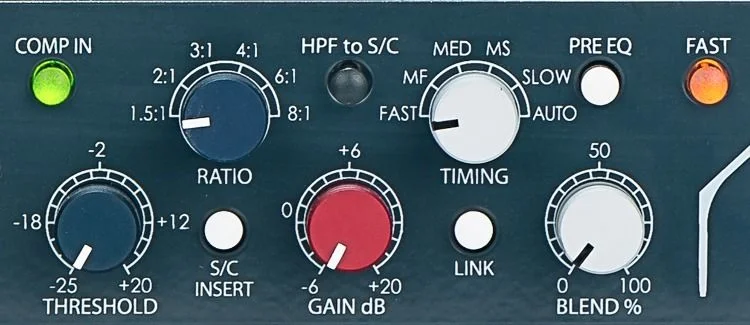




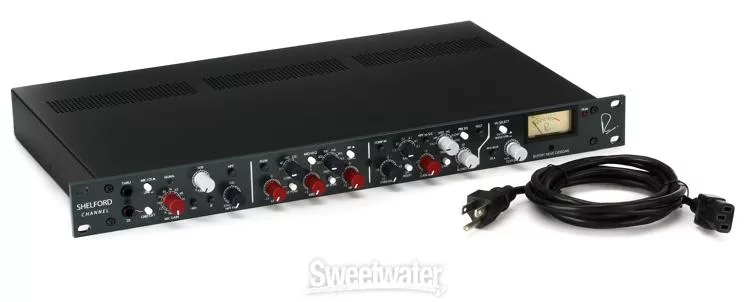










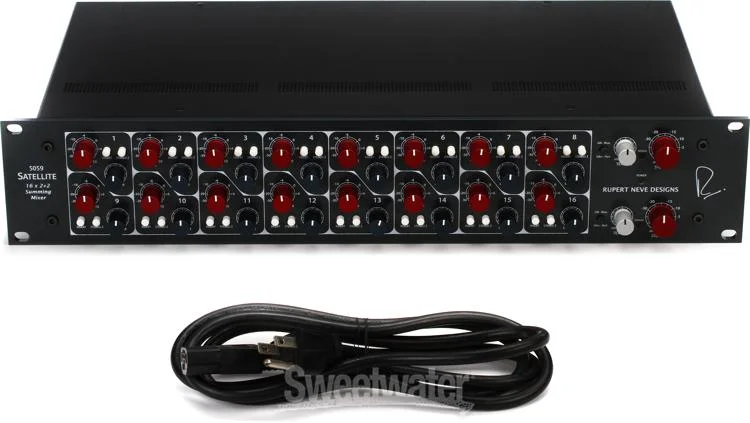



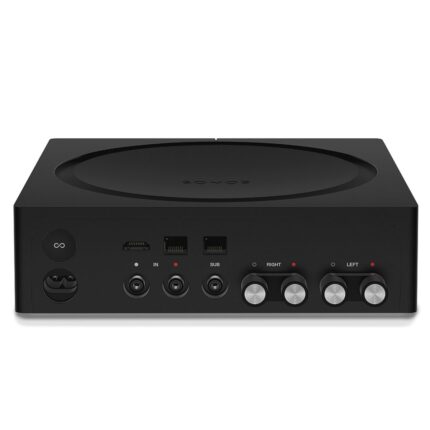
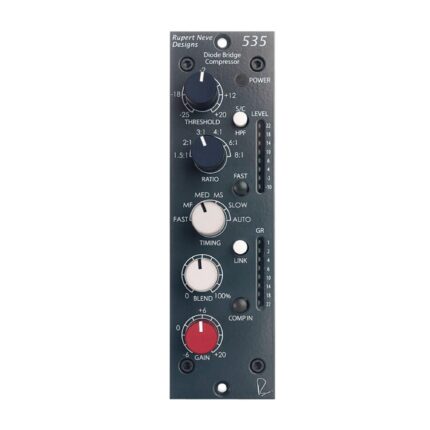





Reviews
There are no reviews yet.